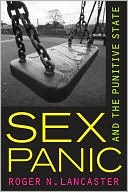 Sex Panic and the Punitive State
Sex Panic and the Punitive State
by Roger N. Lancaster
University of California Press. 328 pages, $24.95 (paper)
SEX PANIC and the Punitive State is part polemic, part social history, and part personal story about the policing of sexual behavior in the United States. As I read the book, the policing of sexual behavior was very much in the news: the sexting scandal of now former Congressman Anthony Weiner and the arrest of IMF Chair Dominique Strauss–Kahn were competing as the distractions du jour.
It is author Roger Lancaster’s contention that “sex panics” in the U.S. track closely with “other forms of institutionalized fear” that the state uses to enforce an increasingly punitive political order. He dates the modern sex panics to the 1970’s, while failing to acknowledge that sex panics targeting gays go back at least as far as the Newport Navy Scandal of 1919 to 1921. That event revealed that homosexuals were now seen as not just a moral problem but potentially a national security problem.
During World War II, there was a purge of homosexuals from the military, and when General Eisenhower was asked for a list of all lesbians on his staff, WAC Sergeant Jonnie Phelps said she would carry out the order but informed the general that the names of the most decorated women would be on that list, including her own. Eisenhower canceled that order but later, as president, signed into being Executive Order 10450 in 1953, which excluded persons with “sexual perversions” from federal employment. (This order was overturned by President Clinton’s Executive Order 11478 on May 28, 1998.)
Lancaster glosses over the 1977 Dade County “Save Our Children” campaign led by Anita Bryant, which in turn inspired California’s Proposition 6 in 1978—the infamous Briggs Initiative—which would have fired teachers who advocated homosexuality (it was voted down). Also oddly missing is the sex panic that resulted in the shuttering of the bath houses and the policing of sexual behavior with the AIDS epidemic in the 80’s. Indeed Lancaster mentions AIDS only once, in passing, throughout the whole book—an astonishing omission.
He does mention that the religious right led by Jerry Falwell continued to vilify gay teachers as child molesters, opining in 1997 that “the homosexual steamroller will crush all decent men, women and children.” He also spends some time on the molestation scandal in the Catholic Church but does so without adding much to the general disapproval.
This book provides a selective window on the use of sex panics and fear-mongering by the state to increase its control over private behavior. It’s a convincing argument and could have been made even more strongly but for the glaring omission of some major episodes in the annals of sex panic and state power.
________________________________________________________
J. A. Myers teaches political science and women’s studies at Marist College in Poughkeepsie, NY.





